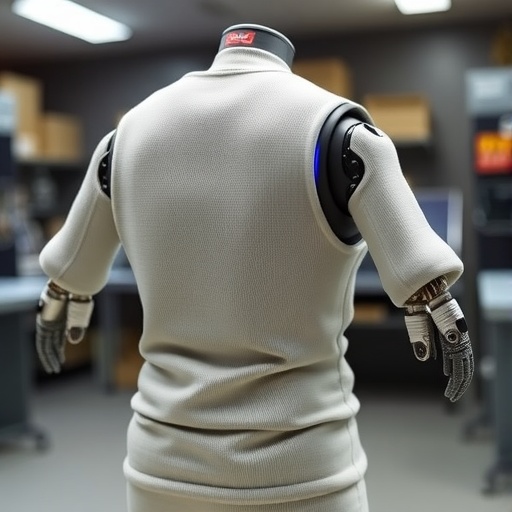In a groundbreaking stride towards revolutionizing wearable robotics, researchers at the Korea Institute of Machinery and Materials (KIMM) have pioneered an innovative automated manufacturing system capable of producing ultra-thin, coil-shaped fabric muscles at scale. This remarkable development harnesses the unique properties of shape memory alloy (SMA) coil yarn, which is remarkably slender, at just 25 micrometers in diameter—thinner than a single human hair—ushering in a new era of lightweight, flexible actuators that integrate seamlessly into textile-based wearable robots.
The advanced weaving technology devised by the team at KIMM’s Advanced Robotics Research Center surmounts critical challenges associated with previous iterations of SMA-based artificial muscles. Earlier versions relied on metallic core wires that hindered elongation and complicated the weaving process, rendering mass production impractical. By ingeniously substituting the rigid metallic core with natural fiber while reengineering the structural and fabrication nuances of the fabric muscle, the researchers achieved continuous, stable, and scalable manufacturing capabilities. The revamped weaving machinery further augments production consistency, marking a vital leap towards commercialization.
The fabric muscle produced by this state-of-the-art system exemplifies an extraordinary strength-to-weight ratio. Despite weighing a mere 10 grams, these actuators can exert lifting forces in the range of 10 to 15 kilograms. This exceptional performance enables wearable robotic suits to provide dynamic assistance across multiple joints, overcoming the limitations imposed by conventional robot actuators. Typically, wearable robots employ bulky, heavy, motorized, or pneumatic systems, which hamper user comfort and limit extended usage, particularly in complex joint movements such as those of the shoulder.
The implications of fabric muscle technology extend profoundly into human-robot interaction domains, especially in wearable exoskeletons designed to augment or restore muscular functions. KIMM researchers have unveiled the world’s first clothing-type wearable robot, weighing under two kilograms, capable of simultaneously supporting the elbow, shoulder, and waist. This innovation achieves a remarkable reduction in muscle effort exceeding 40% during repetitive tasks, dramatically enhancing user endurance and comfort in physically demanding environments.
One of the most notable breakthroughs enabled by this technology is the development of an ultra-lightweight shoulder-assist robot, tipping the scales at just 840 grams. This assistive device has undergone clinical evaluation at Seoul National University Hospital (SNUH) with patients grappling with muscle weakness, including those suffering from Duchenne muscular dystrophy. Results revealed a significant enhancement in shoulder movement range—improving by over 57%—underscoring the potential for wearable robotics to transform rehabilitation and quality of life for individuals with neuromuscular disorders.
Fabric muscles represent a unique class of artificial actuators due to their intrinsic flexibility and conformability. Unlike traditional mechanical actuators, fabric muscles seamlessly integrate into garments, mimicking natural muscle contractions and expansions. This adaptability enables simultaneous assistance across multiple complex joints, conforming to the body’s dynamic contours without impeding natural movement. The synergy between lightweight materials and powerful SMA actuation propels wearable robotics beyond the constraints of bulky exoskeletons, fostering practical adoption in real-world scenarios.
The commercialization potential of KIMM’s fabric muscle technology is particularly compelling in domains such as healthcare, manufacturing, logistics, and construction. By reducing physical fatigue and muscle strain, these wearable robots promise to enhance worker productivity and safety, mitigating occupational hazards associated with repetitive and strenuous tasks. Furthermore, the compact and light design of these devices offers unparalleled user comfort, critical for long-duration wear and widespread acceptance beyond clinical settings.
Beyond industrial applications, the weight-reducing properties and silent operation of fabric muscle actuators address common barriers in the assistive technology sector. Existing devices often evoke resistance due to their conspicuous bulk, noise generation, and limited joint support. KIMM’s fabric muscle-based exosuits offer a discreet, noise-free alternative that integrates naturally into daily life. For patients recovering from muscle degeneration or neuromuscular diseases, this means improved autonomy, enhanced mobility, and an elevated sense of dignity, all critical factors influencing therapeutic outcomes.
From a technical perspective, the shape memory alloy coils central to these fabric muscles exploit the thermo-mechanical phase transformation of SMA materials. When electrically stimulated, the SMA wire contracts, generating force, and upon cooling, it returns to its original shape. The natural fiber core provides structural support and flexibility, perfectly balancing mechanical resilience with lightweight design. This meticulous engineering at the microscale facilitates large-scale textile weaving—a fusion of materials science and automated manufacturing precision.
The integration of these fabric muscles into complete wearable robotic systems demands sophisticated control algorithms, sensors, and power management to enable responsive, real-time assistance. KIMM’s research not only delves into material innovation but also encompasses system-level design, optimizing actuation sequences to synchronize with human biomechanics. Such comprehensive development paves the way for adaptive exosuits that respond intuitively to users’ movements and intentions, heralding a future where assistive robotics effectively become extensions of the human body.
The societal impact of this advancement is profound. By alleviating the physical burdens on industrial workers and empowering individuals with neuromuscular impairments, fabric muscle exosuits contribute to a more inclusive and efficient workforce. The anticipated reduction in caregiver strain—owing to enhanced patient independence—further amplifies the technology’s benefits, offering a ripple effect that may transform home care and rehabilitation paradigms globally.
The research, honored with the prestigious KIMM Best Research Award 2024, represents a collaborative triumph supported by government funding bodies including the Ministry of Trade, Industry and Resources (MOTIR), and Seoul National University Hospital’s Lee Kun-hee Child Cancer and Rare Disease Project. The findings were disseminated in a leading journal, IEEE Transactions on Neural Systems and Rehabilitation Engineering, underscoring the international scientific community’s recognition of the innovation’s significance.
Looking forward, KIMM’s team, under the leadership of Principal Researcher Dr. Cheol Hoon Park, aims to accelerate the transition from laboratory prototypes to commercial products. By refining their automated fabrication systems and expanding application range, they aspire to spearhead global wearable robotic markets. This vision situates Korea at the forefront of robotics innovation, delivering cutting-edge solutions that blend artistic textile manufacturing and advanced robotics to redefine human capability.
In summary, the fusion of ultra-thin shape memory alloy coil yarn with advanced automated weaving introduces a paradigm shift in wearable robotics. Lightweight, flexible fabric muscles capable of continuous mass production enable versatile, comfortable exosuits that support complex joint movements. This technology not only enhances human physical performance but also promises transformative impacts for rehabilitation medicine and industrial labor, affirming a future enriched by invisible, yet powerful wearable robotics.
Subject of Research: Development and mass production of lightweight, flexible fabric muscles for clothing-type wearable robots using shape memory alloy coil yarn.
Article Title: Soft Exosuit Based on Fabric Muscle to Assist Shoulder Joint Movements in Patients With Neuromuscular Diseases
News Publication Date: 24-Sep-2025
Web References:
Korea Institute of Machinery and Materials (KIMM): https://www.kimm.re.kr/eng
DOI Link to Article: http://dx.doi.org/10.1109/TNSRE.2025.3613709
Image Credits: Korea Institute of Machinery and Materials (KIMM)
Keywords: Wearable robotics, Fabric muscle, Shape memory alloy, Automated weaving, Exosuit, Neuromuscular assistance, Soft actuators, Rehabilitation engineering, Lightweight actuators, Textile robotics, Shoulder assist robot, Mass production technology
Tags: advanced weaving technology innovationsartificial muscle developmentautomated manufacturing of fabric musclescommercialization of wearable robotsKIMM research advancementslightweight flexible actuatorsnatural fiber integration in roboticsscalable production of wearable technologyshape memory alloy applicationsstrength-to-weight ratio in roboticstextile-based wearable robotswearable robotics technology





